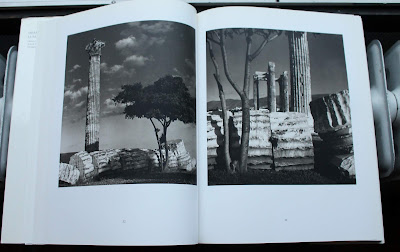Lumière sur la Grèce door Herbert List (Fotograaf)
(1993)
|
Herbert List, German photographer, 1903 – 1975
His austere, classically-posed black-and-white compositions, particularly of male nudes, taken in Italy and Greece have been highly formative for modern photography.
From 1937 to 1939 Herbert List traveled in Greece and took photographs of ancient temples, ruins, sculptures, and the landscape, many of which were published in magazines and books (Life, Photographie, Verve and Harpers Bazaar) and also works on his first book called “Licht Ueber Hellas”, which won’t be published until 1953.
Herbert List (1903–1975), born into a successful mercantile family in Hamburg, Germany. While still a student, studying literature at the University of Heidelberg, List became apprenticed to his family’s coffee business. During the mid-1920s, while traveling to plantations throughout the Caribbean, Central and South America, he began to take photographs. In 1930, List met the photographer, Andreas Feininger, who introduced him to the Rolleiflex camera, and List began making portraits of friends and shooting still-lifes . List explained that his experimental photographs were “composed visions where [my] arrangements try to capture the magical essence inhabiting and animating the world of appearances.” Developing an elegant and distinctive style, List combined in his photography a classical education with a lyrical sensibility infused with Surrealist aesthetics . He was also influenced by the principles of the Bauhaus and the New Objectivity. In 1936, List turned professional, working in Paris and London, where he was referred to Harper’s Bazaar, by no less than Hoyningen-Huene. Unsatisfied with fashion, the artist returned to the still-life, producing images in a style he called “fotografia metafisica”. From 1937 to 1939, List traveled through Greece recording ancient ruins, sculpture and the landscape, for publication. During the Second World War, List, who had tried unsuccessfully to reach America, was forced to serve in the German army, and he spent the latter part of the war serving in Norway in at a job related to map design. In 1944 he took an opportunity to visit occupied Paris on business, and wound up making portraits of art world figures such as Picasso and Christian Bérard. After the war, List photographed the ruins of Munich. He also made time for more of his own drawing ( there were over 500 left in his estate ) as well as for the collecting of old master drawings. In 1950, List created haunting, ironic portraits in the Palermo catacombs. In 1952 List was persuaded by Robert Capa to work with Magnum on a project on European post-war youth. List spent a good portion of the next decade in Italy, and started working with a 35mm camera and telephoto lens. During this time he continued with his passion of creating portraits of artists and writers. In 1957-58 after 30 years, List returned to the Caribbean on assignment, photographing the natives’ mystic rituals for the Swiss magazine Du. In Mexico he worked in portraiture and dabbled in color. The next 15 years were likewise busy with travel, photography and publications. In the last years of his life, List turned down requests for retrospective exhibitions of his photographs but did work on a special issue of Du honoring his 70th birthday. List died in Munich in 1975. List has works in scores of public institutions : the Benaki Museum in Athens; the Museum Ludwig, Cologne; Museum Folfwang, Essen; the Getty, Los Angeles; the Metropolitan Museum of Art, New York; the Centre Georges Pompidou, Paris; and the Kunsthaus, Zurich.
































Geen opmerkingen:
Een reactie posten